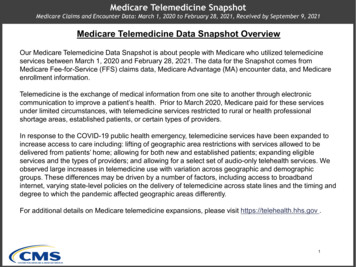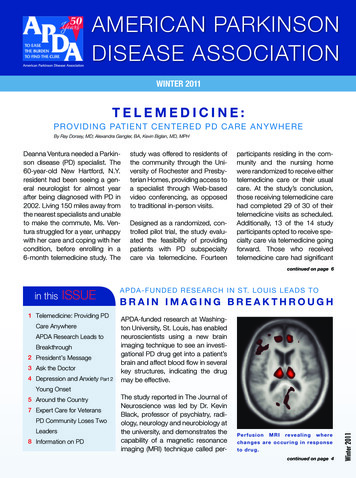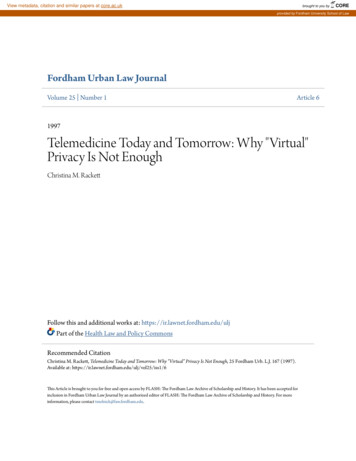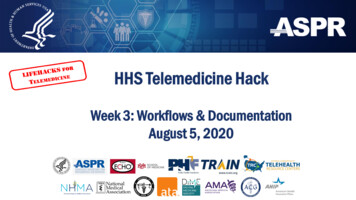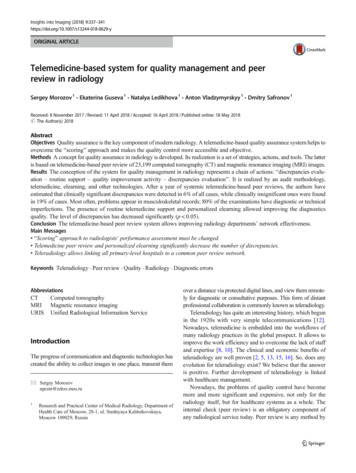
Transcription
Insights into Imaging (2018) -yORIGINAL ARTICLETelemedicine-based system for quality management and peerreview in radiologySergey Morozov 1 & Ekaterina Guseva 1 & Natalya Ledikhova 1 & Anton Vladzymyrskyy 1 & Dmitry Safronov 1Received: 8 November 2017 / Revised: 11 April 2018 / Accepted: 16 April 2018 / Published online: 18 May 2018# The Author(s) 2018AbstractObjectives Quality assurance is the key component of modern radiology. A telemedicine-based quality assurance system helps toovercome the Bscoring approach and makes the quality control more accessible and objective.Methods A concept for quality assurance in radiology is developed. Its realization is a set of strategies, actions, and tools. The latteris based on telemedicine-based peer review of 23,199 computed tomography (CT) and magnetic resonance imaging (MRI) images.Results The conception of the system for quality management in radiology represents a chain of actions: Bdiscrepancies evaluation – routine support – quality improvement activity – discrepancies evaluation . It is realized by an audit methodology,telemedicine, elearning, and other technologies. After a year of systemic telemedicine-based peer reviews, the authors haveestimated that clinically significant discrepancies were detected in 6% of all cases, while clinically insignificant ones were foundin 19% of cases. Most often, problems appear in musculoskeletal records; 80% of the examinations have diagnostic or technicalimperfections. The presence of routine telemedicine support and personalized elearning allowed improving the diagnosticsquality. The level of discrepancies has decreased significantly (p 0.05).Conclusion The telemedicine-based peer review system allows improving radiology departments’ network effectiveness.Main Messages BScoring approach to radiologists’ performance assessment must be changed. Telemedicine peer review and personalized elearning significantly decrease the number of discrepancies. Teleradiology allows linking all primary-level hospitals to a common peer review network.Keywords Teleradiology . Peer review . Quality . Radiology . Diagnostic errorsAbbreviationsCTComputed tomographyMRI Magnetic resonance imagingURIS Unified Radiological Information ServiceIntroductionThe progress of communication and diagnostic technologies hascreated the ability to collect images in one place, transmit them* Sergey Morozovnpcmr@zdrav.mos.ru1Research and Practical Center of Medical Radiology, Department ofHealth Care of Moscow, 28-1, ul. Srednyaya Kalitnikovskaya,Moscow 109029, Russiaover a distance via protected digital lines, and view them remotely for diagnostic or consultative purposes. This form of distantprofessional collaboration is commonly known as teleradiology.Teleradiology has quite an interesting history, which begunin the 1920s with very simple telecommunications [12].Nowadays, telemedicine is embedded into the workflows ofmany radiology practices in the global prospect. It allows toimprove the work efficiency and to overcome the lack of staffand expertise [8, 10]. The clinical and economic benefits ofteleradiology are well proven [2, 5, 13, 15, 16]. So, does anyevolution for teleradiology exist? We believe that the answeris positive. Further development of teleradiology is linkedwith healthcare management.Nowadays, the problems of quality control have becomemore and more significant and expensive, not only for theradiology itself, but for healthcare systems as a whole. Theinternal check (peer review) is an obligatory component ofany radiological service today. Peer review is any method by
338which radiologists are reviewing their colleagues’ cases for avariety of purposes, such as credentialing, re-credentialing,and/or quality checks. In the USA, Joint CommissionInternational (JCI) requires a departmental peer review forthe accreditation of hospital radiology departments.Therefore, almost all radiology departments, at least in academic institutions, participated in a form of peer review process. The radiology department or the parent health system isfree to decide how this peer review is performed [14]. Thegoal of the peer review in radiology is to improve the overallperformance by recognizing unperceived findings on diagnostic studies and identifying opportunities for improvement.The problem of peer review in radiology is that, mostoften, this is an internal procedure. This affects both theobjectivity of the quality control and its accessibility, especially in primary-level hospitals with limited personnel. Insum, current peer review models are usually focusing on theBscoring of errors and not on their Belimination . In addition, the Bscoring approach may create tension betweenradiologists [2, 6].Our team believes that the future of teleradiology is thedistant peer review process, as this is the perfect tool forhealthcare improvement. This approach allows increasingquality control and objectivity. On the other hand, not only atelemedicine peer review but also a system of linked actionsfor quality assurance in radiology should be developed. Sucha system has to replace the Bscoring approach with moreadvanced and effective strategies.The objective of this paper was to create and evaluate theefficiency of a telemedicine-based quality assurance system inradiology.Materials and methodsA concept and system for quality assurance in radiology wasdeveloped. The concept was realized at the beginning of 2016as a set of strategies, actions, and tools.For a period of one year (August 2016 to September 2017),all computed tomography (CT) and magnetic resonance imaging (MRI) images, performed in municipal outpatient hospitals of Moscow, were uploaded to the regional radiologicalsystem. From this general sample (n 380,515), a set of studies (n 23,199) was randomly selected and directed for a peerreview. Prior to the peer review, personal data were removed,thus ensuring the anonymity of the patients. A group of experts, two or three for each record, performed the distant peerreview. The logistics of the peer review consists of severaliterations. If one of the experts considers that the discrepancyis significant, the system sends the study to the another expert.In case that the second expert disagrees with the conclusionsof his colleague, the study is redirected for final evaluation tothe third expert of the same subspecialty.Insights Imaging (2018) 9:337–341The quality control focuses on:––Technical performance: artifacts, selection of the studyregion, patient’s positioning, scanning technique, contrastenhancement timing and phases, pulse sequences, etc.Diagnostic performance: detection of pathology, discrepancies in the interpretation, terminological errors, etc.The scoring consists of four grades:1. No discrepancy;2. General remarks: comments on terminology, protocol design, etc.;3. Discrepancy insignificant from clinical point of view, notaffecting the treatment and/or the quality of life;4. Discrepancy significant from clinical point of view, hypothetically affecting the treatment and/or the quality of life.The outcomes were assessed comparing the levels of thesignificant/insignificant discrepancies during the first and lastquarters of the study period.The descriptive statistics included means and standard deviations. Since the data were normally distributed (Shapiro–Wilk test), the parametric t-test was used for the analysis. Thelevel of significance was set at p 0.05. Statistical analysiswas performed with MedCalc software.ResultsThe theoretical concept of a telemedicine-based peer reviewrepresents a cycle of actions that may be presented as a chain:Bdiscrepancies evaluation – routine support – quality improvement activity – discrepancies evaluation . In a nutshell, itreflects the quality improvement PDCA (plan-do-check-act)cycle. In a few words:–––The evaluation is based on an independent blinded peerreview method and a formal classification of discrepancies.The routine support includes teleconsultations bysubspecialized radiologists and technical support.The quality improvement activity involves different typesof elearning, such as web courses, webinars, online workshops, etc., with personal learning strategies. It can alsoinclude some administrative actions, but only in especially difficult and vague clinical cases.When the methodology just described is combined with atelemedicine network, a new tool for quality management inradiology is available. The authors succeeded in turning thetheory into practice.In 2015, the Unified Radiological Information Service(URIS) was created and launched. This is a radiological
Insights Imaging (2018) 9:337–341information system which unites 75 outpatient municipal hospitals, plus the Expert and eLearning Center, which wasestablished at the Research and Practical Center of MedicalRadiology, Department of Health Care of Moscow. The URIScombines 62 CT, 40 MRI, 30 digital mammography units, andapproximately 400 radiologists and technicians. At the time ofthe preparation of the manuscript, more than a million studiesand their reports have been uploaded to the system.Most important is that the URIS is not an archive of medical images. Instead, it is a telemedicine network, with a distributed archive, with an implemented workflow and qualityimprovement cycle.Every CT or MRI image or digital mammography arrives atthe URIS. Each radiologist may submit a case forteleconsultation to the Expert and eLearning Center. The onlyrequirement is to follow the preliminary distributed guidelines. The efficiency of the telemedicine consultation has beenpublished elsewhere.The URIS also allows monitoring the equipment parameters(loads, functions, protocols, doses) via a digital dashboard.Hence, the technicians can receive recommendations aboutthe equipment settings if and when necessary. All of these actions are part of the daily routine support provided by the URIS.Approximately 7% of all studies are randomly selected andsent for peer review. When systemic discrepancies are detected, a personal learning strategy is developed. The latter can befocused either on the departmental management or on a physician or a technician.We have had this workflow in place within the URIS sinceDecember 2016. During this period 23,199 studies were randomly selected for peer review.Clinically significant discrepancies were detected in 6% ofall cases during the research period of 12 months. Clinicallyinsignificant discrepancies were found in 19% of the cases.Most frequently, discrepancies have been revealed in thereporting of pancreas (28%), lymph nodes and peritoneum(18%), anterior abdominal wall (18%), liver (12%), pelvis(12%), and intestine (9%). The frequency of discrepancieswas different in various diagnostic groups. Most often, problems appeared in oncology (46%; clinically significant - 9%,insignificant - 37%), infections (32%; 7% and 27%, respectively), and cardiovascular examinations (24%; 5% and 19%,respectively). The worst situation was for musculoskeletal imaging; almost 80% of studies had technical or diagnostic discrepancies. The highest level of diagnostic imperfections wasdetected in case of trauma MRI (70%). At the same time, therewere only 26% of trauma CTs with discrepancies.The detection of the technical deficits during the peer reviewand the special support of technicians is very important. Thetechnical aspects of the examination critically influence the radiologists’ decision-making. A moderate correlation betweenthe discrepancies and inadequate technique (correlation coefficient 0.5, p 0.05) or artifacts (correlation coefficient 0.3,339p 0.05) for trauma cases was revealed. The technical problems most often detected were for pelvis MRI (55%), i.e., patient and slice positioning (43%), field-of-view selection (23%),and pulse sequence selection (19%) For CT, the most problematic areas are the neck and the larynx. Approximately 42% ofstudies were performed with technical imperfections.The detected problems and methods of their future prevention were described in more than 220 elearning activities (including 27 web courses for 1955 radiologists, 98 webinars, 82workshops, etc.). The regular broadcasting and free access tothe records have made our webinars very popular in the professional environment. In 2017, 10,200 students from 20 regions of Russia and Commonwealth of Independent States(CIS) countries also took part in the above elearning activities.The presence of routine telemedicine support and anelearning system allowed improvement of the quality of thediagnostics. One year after the establishment of the URIS, avalid decrease of imperfections (p 0.05) was observed. Thelevel of clinically significant discrepancies decreased from6.4 2.9% (64) to 2.8 0.8% (104). The number of generalremarks remained roughly the same [22.4 3.0% (226) vs.18.6 1.59% (691)] (Fig. 1).The presence of the technical and medical data from thecity hospitals’ network allows detecting and eliminating systemic diagnostic problems. For example, at the beginning ofthe research period, it was found that 66% of the outpatientexaminations were performed without intravenous contrastenhancement. There was a correlation between the inadequatescanning parameters (CT without contrast enhancement) andthe diagnostic discrepancies in cancer patients (correlationcoefficient 0.6, p 0.05). This result invoked a special strategy focused on learning, information sharing, and generalawareness about contrast enhancement. The number of outpatient CTs with contrast enhancement increased by a factor of2.1 in a 6-month period due to the realized strategy.Finally, the authors discovered that 90% of studies withimperfections belong to a limited group of specialists: 11%of radiologists and 17% of technicians. This result allowedto personalize and focus the learning strategies.DiscussionIn the context of radiology quality performance evaluation viatelemedicine, the results presented here are in parallel withanother research [1]. A study with dual reporting was conducted in a parallel reading environment in a teleradiology practicefor 3779 radiological procedures, performed at two radiologycenters in the USA over a period of 4 months. The examination type was significantly related to error frequency (p 0.0001), with higher than average frequencies of errors seenfor CT of the abdomen and pelvis and MRI of the head andspine, but lower than average for the head and spine CT, and
340Insights Imaging (2018) 9:337–341Fig. 1 The effectiveness of atelemedicine-based quality assurance system: the rate (%) of thediscrepancies and the correct radiologic reports before (Q3 2016)and after (Q3 2017) the implementation of the systemfor ultrasound [1]. Otherwise, there is a majority of discrepancies related to the head CTs. Comparison of the conventional approach and the teleradiology system allows detectingmajor discrepancies in 5.8% of cases and minor discrepanciesin 21.1% of the cases [7]. Differences in the classifications ofthe discrepancies create barriers for an objective comparison.The authors may have only observed the parallels in the higherlevels of imperfections for the neck CTs.Our telemedicine-based peer review has been introducedfor quality improvement in the whole network of municipaloutpatient hospitals. It was clarified that physician errors, discovered in the peer review process, should be used not forpunishment, but for the life-long education of the radiologist,perhaps in the form of challenging/missed cases or morbidity–mortality conferences and virtual webinars [14].Recently published papers on the peer review experienceidentify important opportunities to create a non-punitive peerreview system, truly focused on learning from the errors we allmake [9]. It was mentioned that radiologists’ reporting performance cannot be perfect and some errors are inevitable. Thepeer review system should create strategies to minimize errorsand to learn from them [2]. The system of quality control inradiology should progress beyond the counting of errors andmove on to group learning and error prevention [11]. Theauthors firmly believe that their approach, concept, and resultsclosely correspond with the above-mentioned ideas. The results have already proved this.Moreover, previous researches have demonstrated a numeric scoring of discrepancies. Our research aims to demonstratehow the quality performance evaluation positively influencesradiologists’ and technicians’ skills and affects the healthcaresystem in general. Due to the combination of technology,learning, and management, the authors have successfullyachieved a Btransition from a peer-review to a peer-learningapproach [3] in radiology.No doubt, the presented study has some limitations. Themost serious one is the absence of an internationallyrecognized system of classifying the discrepancies and imperfections in radiology. Such a system has to be developed infurther researches. Another limitation is the sample size for theregular audit. There is a theory that valuable information couldbe obtained when sampling at least 2.5% of each radiologist’svolume, with a maximum of 300 cases [4]. However, the authors believe that the effective sample size should be clarifiedin further studies. Finally, there are limitations in the comparison with other publications, due to the limited list of modalities available in the URIS as present.ConclusionThe Bscoring approach to a radiologist’s performance assessment is replaced by a more sophisticated evaluation method.The distant peer review process is applied for a systemic imperfections detection. Quality improvement strategies are developed. The latter unite different actions (learning, management,etc.) and are specially developed for the concrete radiologydepartment. Thus, quality improvement procedures becomemore personal and more effective.The new approach has allowed improvement of the diagnostics quality. The rate of discrepancies has decreased significantly (p 0.05) after one year following a systemictelemedicine-based peer review.Future research will be devoted to the standardization of thepeer review methodology and to the development of Bbig data tools for the monitoring and management of a radiology service.Open Access This article is distributed under the terms of the CreativeCommons Attribution 4.0 International License (http://creativecommons.org/licenses/by/4.0/), which permits unrestricted use,distribution, and reproduction in any medium, provided you give appropriate credit to the original author(s) and the source, provide a link to theCreative Commons license, and indicate if changes were made.
Insights Imaging (2018) 9:337–341References1.Agrawal A, Koundinya DB, Raju JS, Agrawal A, Kalyanpur A(2017) Utility of contemporaneous dual read in the setting of emergency teleradiology reporting. Emerg Radiol 24(2):157–1642. Brady AP (2017) Error and discrepancy in radiology: inevitable oravoidable? Insights Imaging 8(1):171–1823. Donnelly LF, Larson DB, Heller RE III, Kruskal JB (2018)Practical suggestions on how to move from peer review to peerlearning. AJR Am J Roentgenol 210:578–5824. Eisenberg RL, Cunningham ML, Siewert B, Kruskal JB (2014)Survey of faculty perceptions regarding a peer review system. JAm Coll Radiol 11:397–4015. Giansanti D (2017) Teleradiology today: the quality concept andthe Italian point of view. Telemed J E Health 23(5):453–4556. Larson DB, Donnelly LF, Podberesky DJ, Merrow AC, Sharpe REJr, Kruskal JB (2017) Peer feedback, learning, and improvement:answering the call of the Institute of Medicine report on diagnosticerror. Radiology 283(1):231–2417. Platts-Mills TF, Hendey GW, Ferguson B (2010) Teleradiologyinterpretations of emergency department computed tomographyscans. J Emerg Med 38(2):188–1958. Sabour S (2017) Reliability of smartphone-based teleradiology forevaluating thoracolumbar spine fractures: statistical issue to avoidmisinterpretation. Spine J 17(8):12009. Scali EP, Harris AC, Martin ML (2017) Peer review in radiology:how can we learn from our mistakes? Can Assoc Radiol J 68(4):368–370. .12.13.14.15.16.Silva E 3rd, Breslau J, Barr RM et al (2013) ACR white paper onteleradiology practice: a report from the Task Force onTeleradiology Practice. J Am Coll Radiol 10(8):575–585Strax R (2017) Peer review: past, present, and future. J Am CollRadiol 14(2):188–190Vladzymyrskyy A, Jordanova M, Lievens F (2016) A century oftelemedicine: curatio sine distantia et tempora. Sofia. InternationalSociety for Telemedicine & eHealth (ISfTeH). Web. 10 Oct 2017.https://www.isfteh.org/news/a century of telemedicine curatiosine distantia et tempora. book by antonVladzymyrskyy A, Mozgovoy V, Bondarenko S (2014) A telemedicine network for managing multidrug-resistant tuberculosis. JTelemed Telecare 20(2):113–114Walker EA, Petscavage-Thomas JM, Fotos JS, Bruno MA (2017)Quality metrics currently used in academic radiology departments:results of the QUALMET survey. Br J Radiol 90(1071):20160827Watson JJ, Moren A, Diggs B et al (2016) A statewide teleradiologysystem reduces radiation exposure and charges in transferred trauma patients. Am J Surg 211(5):908–912Wootton R, Wu W, Bonnardot L (2014) Store-and-forwardteleradiology in the developing world—the CollegiumTelemedicus system. Pediatr Radiol 44(6):695–696Publisher’s NoteSpringer Nature remains neutral with regard to jurisdictional claims inpublished maps and institutional affiliations.
telemedicine network, a new tool for quality management in radiology is available. The authors succeeded in turning the theory into practice. In 2015, the Unified Radiological Information Service (URIS) was created and launched. This is a radiological 338 Insights Imaging (2018) 9:337-341
